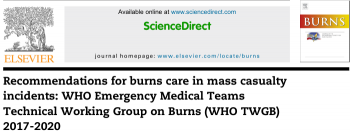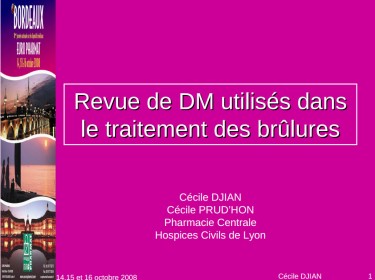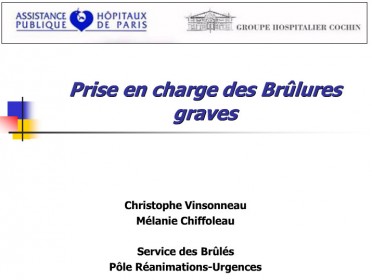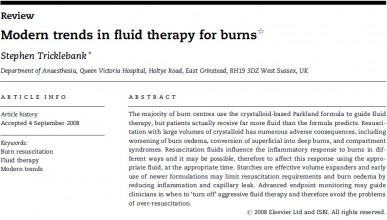14/12/2023
Brûlures: Pensez au phosphore blanc !
Evidence for chemical burns by white phosphorus in Armenian soldiers during the 2020 Nagorno-Karabakh war
Son Brutyan S et Al. Injury. 2021 Apr;52(4):1100-1101.
La reconnaissance précoce des brûlures au phosphore blanc est fondamentale du fait du risque d'arrêt cardiaque liée à une hypocalcémie majeure. L'élimination rapide des particules de phosphore, le refroidissement des zones touchées par pansement humide et la réanimation hydroélectrolytique bien conduite sont essentiels. Pendant la guerre du Haut-Karabakh de 2020, les chirurgiens et les spécialistes des soins intensifs du Centre national des brûlés d'Erevan, en Arménie, ont été confrontés à un afflux important de brûlés présentant des brûlures creusantes, fluorescente à l'observation sous lumière ultraviolette et associées à une hypocalcémie profonde. Une meilleure sensibilisation aux conséquences des blessures par phosphore blanc est spécifique et peut sauver des vies.
| Tags : phosphore
29/10/2022
Refroidir la brulure: OUI
The effect of 20 minutes of cool running water first aid within three hours of thermal burn injury on patient outcomes: A systematic review and meta-analysis
Griffin B. et Al. Australas Emerg Care. 2022 Dec;25(4):367-376.
Background:
Burn injuries are a leading cause of morbidity that can result in devastating disability and poor quality of life for survivors. This systematic review aimed to synthesise evidence regarding the effect of 20 minutes of cool running water (CRW) within three hours of injury on outcomes of patients with thermal burn injuries.
Methods:
This systematic review was conducted in reference to the Preferred Reporting Items for Systematic Reviews and Meta-Analyses. Multiple databases (PubMed, EMBASE, CENTRAL, CINAHL Complete via EBSCO, PROQUEST Dissertations and Theses), and the Australia New Zealand Clinical Trial Registry were searched for eligible studies published in English and Chinese, without date restriction. Meta-analyses were undertaken Methodological quality of studies was assessed by using Downs and Black Checklist.
Results:
Of 323 records, seven studies were included. The majority (67%) of studies were conducted in Australia and New Zealand. The methodological quality was ranked between 'fair' and 'good'. Twenty minutes of CRW within the first three hours of burn injury significantly decreased the odds of patients requiring skin grafting and surgical intervention for wound management.
Conclusions:
There is considerable evidence suggesting the application of 20 min of CRW within the first three hours of injury improves outcomes for patients with burn injury. Consensus between burn organisations and collaborative efforts to translate evidence into practice are needed to optimise burn first aid care which can improve patient outcomes globally.
05/02/2021
Brûlures et afflux massifs
01/07/2016
U.K. Military Burns 2008–2013
Epidemiology of U.K. Military Burns 2008–2013
J Burn Care Res. 2016 Jun 2. [Epub ahead of print]
After sustaining burn injuries overseas, U.K. Armed Forces personnel are evacuated to the Royal Centre for Defence Medicine. The objective was to review the etiology of U.K. Military burns managed at the center between 2008 and 2013. Analysis will aid provision planning and assist in the prevention of burn injuries for future tours. The International Burn Injury Database database of all U.K. Armed Forces burn injured patients evacuated to the Queen Elizabeth University Hospital Birmingham between 2008 and 2013 were reviewed retrospectively. Analysis included patient demographics, injury mechanism, burn severity, management, and mortality. There were 65 military personnel with burn injuries requiring repatriation to the United Kingdom. Percentage of 78.5 were sustained in Afghanistan. The mean age was 25 (18–46) years. Percentage of 70.8 were considered noncombat burn injuries. Of the noncombat burns, the mechanism of injury most commonly involved burning waste and misuse of fuels and scalds.
| Combat | |
| Improvised explosive device | 10 |
| Unintentional detonation of ammunition | 3 |
| Rocket propelled grenade | 2 |
| Mini-flare fired into face | 1 |
| Explosion during training | 1 |
| Thermal injury from fired bullet | 1 |
| White phosphorus flame burn | 1 |
| Non combat | |
| Misuse of fuel | 11 |
| Burning waste | 7 |
| Cooking | 4 |
| Others | 16 |
| Total | 65 |
"...One fifth of all patients sustained associated injuries, of which 88.3% were personnel with combat burns. Associated injuries included complex fractures,
tympanic injuries, ophthalmic injury, spinal injury, lung contusions, a gunshot wound to the upper limb and a gunshot wound causing an intracranial hemorrhage. One patient required bilateral lower limb amputations. In addition, two patients sustained an associated inhalation injury..."
The mean TBSA for all patients was 6% (0.05–51%). Areas most commonly affected included arms, legs, and face. The length of hospital stay for combat vs noncombat burn injury patients was 10 vs 7 days. There were no fatalities. In conclusion, substantially fewer military personnel sustained combat burns between 2008 and 2013 than in preceding study period (19 vs 79). The number of accidental noncombat burns remained constant. The decrease in combat burns may reflect a relative decrease in military intensity and effective protective equipment and safety measures. Further education may allow for an additional decrease in preventable burn injuries.
| Tags : brûlure
07/04/2016
Brûlés: Moins grave qu'imaginé mais toujours spécifique
One year of burns at a Role 3 Medical Treatment Facility in Afghanistan
Jeevaratnam JA et Al. J R Army Med Corps. 2014 Mar;160(1):22-6
-------------------------------
L'expérience UK afghane confirme dans ce type de conflits la particularité des brûlures de guerre: Finalement peu fréquentes souvent isolées (72%), relativement peu étendues portant sur la face, associée à des brûlures respiratoires/inhalation de fumées (13%) et associés à d'autres lésions traumatiques (27%) qui peuvent être au premier plan. 6% sont intubés. Il n'en demeure pas moins que la chaîne de prise en charge se doit d'être spécifique avec le respect de délai de prise en charge en particulier du fait des techniques d'excision-greffe nécessaire et des besoins transfusionnels souvent importants.
-------------------------------
OBJECTIVES:
Historically, burns have formed a significant proportion of the casualties of war. The management of burns in recent conflict has been found to be a resource-heavy undertaking, though its impact on both personnel and resources in current conflicts is unclear. A case analysis has been carried out in order to quantify the logistical impact of the management of burns on Role 3 Medical Treatment Facility (MTF) infrastructure and to examine if and how the cause and management of burns have evolved in early 21st century conflict.
METHODS:
All casualties treated for burns at a Role 3 MTF over one calendar year were identified and scanned copies of their notes obtained from the UK Joint Theatre Trauma Registry and retrospectively analysed.
RESULTS:
88 of the 1461 (6.0%) trauma patients presenting to the Role 3 MTF over the year were treated for burns of whom 52.3% were combat troops and 45.4% civilians. Half of the burns were caused by non-conflict related mechanisms; the two commonest mechanisms were flame burns in 38/88 mostly non-conflict related cases and blast in 30/88 cases most of which were conflict related.

CONCLUSIONS:
The management of burns at war is a complex process. It is further confounded by the management of civilians with non-conflict related burns, which places a predictable strain on Role 3 MTF resources: theatre time, nursing time, dressing resources and bed space. This must be planned for in current and future deployed operations.
20/12/2015
Brûlés: Pas plus de suicides que les autres ?
Postdischarge Cause-of-Death Analysis of Combat-Related Burn Patients
Escolas SM et Al. J Burn Care Res 2015;XXX:00–00
----------------------------------------------
Le document proposé rapporte le devenir des blessés brûlés par l'armée américiane lors des conflits afhgans et irakiens. Ces brûlés ont une surface moyenne relativement faible de l'ordre de 12% pour un ISS de 9 et une durée moyenne d'hospitalisation de 15 jours. La mortalité à long terme apparaît elle aussi plutôt faible de l'ordre de 1.3%. La brûlure ne serait donc pas un facteur aggravant notamment de suicide chez ces combattants. L'inclusion des ces combattants dans des programmes très structuré de réhabilitation et un lien social très fort expliquerait ces données.
----------------------------------------------
Combat operations in Iraq and Afghanistan have resulted in up to 8.8% of combat-related casualties suffering burns. From World War I through Desert Storm, burns have been associated with approximately 4% of the combat-related deaths. Experiencing a blast injury and exposure to killing and death while deployed has been shown to increase suicide risk. Although several studies of military populations have investigated risk factors for death among burn patients during the acute phase, no studies have reported mortality rates, cause-of-death, or the prevalence of suicide after hospital discharge. This study examined the case fatality rate, causes of death, and the prevalence of suicide among 830 combat burn patients discharged from the sole burn center in the U.S. Department of Defense, between March 7, 2003 and March 6, 2013. Cause-of-death was determined through the Armed Forces Medical Examiner’s Office and the Office of the Secretary of Defense’s National Death Index. A total of 11 deaths occurred among the 830 burn survivors, for an overall case fatality rate of 1.3%. Of the 11 who died, five deaths were related to accidental poisoning by exposure to drugs; three were related to operations of war (two after returning to the war zone), and the remaining three died from other accidental causes (one explosion and two vehicle crashes). There was no indication of suicide or suspicion of suicide as a cause-of-death for the former patients included in this study, suggesting that combat burn injury did not appear to increase the risk of death by suicide in our study population. Further research is needed to understand the factors that contribute to the apparent resilience of combat burn survivors.
| Tags : brûlure
08/03/2015
Brûlés et transport aérien
Transport aérien longue distance des brûlés graves: Revue de la littérature et application pratique
Leclerc T. et Al. Annals of Burns and Fire Disasters - Pending Publication
Les brûlés graves nécessitent une prise en charge multidisciplinaire dans descentres hautement spécialisés. La rareté de ces centres impose souvent le transport aérien médicalisé longue distance. Cependant, il y a peu de données publiées sur ces transferts. Dans cette mise au point, pour optimiser la prise en charge des brûlés dès qu’un transport aérien est décidé ou même seulement envisagé, nous proposons d’extraire de cette littérature limitée des principes simples s’appuyant aussi sur l’expérience pratique du Service de Santé des Armées françaises. Nous décrivons d’abord comment les contraintes aéronautiques peuvent affecter le transport de brûlés graves à bord d’aéronefs. Nous abordons ensuite la régulation de ces missions, en analysant les risques associés au transport aérien des brûlés graves et leurs implications sur les indications, la chronologie et les modalités du transport. Enfin, nous développons la conduite de la mission, comprenant la préparation du matériel et des consommables avant le vol, l’évaluation et la mise en condition du patient avant l’embarquement, et la poursuite de la prise en charge en vol
| Tags : brûlure
14/04/2013
Brûlés: Les nouvelles tendances militaires
| Tags : brûlure
Brûlés: L'expérience US
| Tags : brûlure
Brûlure: La procédure US
| Tags : brûlure
Brûlure: OEF/OIF Learned lessons
| Tags : brûlure
Brulure: Une revue des pansements
| Tags : brûlure
Brûlés graves: Flash Conférence SLRF
Brûlés: Un point sur le remplissage vasculaire
| Tags : brûlure
Brûlés: Réanimation initiale
Réanimation initiale du brûlé
Benyamina Mourad & Losser Marie-Reine
Centre de Traitement des Brûlés, Hôpital Cochin
27 rue du Faubourg Saint-Jacques 75679 PARIS Cedex 14
Service d’Anesthésie-Réanimation, Hôpital Saint-Louis,
1 avenue Claude Vellefaux, 75475 PARIS Cedex 10
| Tags : brûlure








